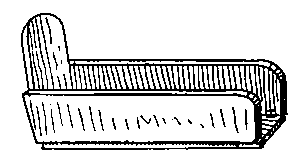Fracture of the Leg - Types Of Fractures
Description
This section is from the book "The Home Hand-Book of Domestic Hygiene and Rational Medicine. Volume 2.", by J. H. Kellogg, M.D.. Also available from Amazon: The Home Hand-Book of Domestic Hygiene and Rational Medicine, Volume 2.
Fracture of the Leg - Types Of Fractures
Either one or both bones of the leg may be fractured. The tibia, or inner bone of the leg, which forms the shin, although much stronger and larger than the outer bone, is most frequently broken on account of being less well protected by muscles. What is known as Pott's fracture is an injury in which the outer bone of the leg is broken at a point about three inches above the ankle, and the inner ankle; is either broken or separated from the heel bone by laceration of the ligaments. The result of this accident is turning of the sole of the foot inward. When the tibia is broken, the point of fracture can generally be quite easily found by feeling along the shin. The outer bone is so thoroughly covered by muscles that it cannot be so easily felt, but the crepitus can generally be distinguished.
The Treatment of Fracture of the Leg
The bone should be set, and the limb placed in the fracture box, an illustration of which maybe seen in Fig. 375. A piece of cloth a yard long and about two feet wide should be placed in the box in such a way as to cover the bottom and sides, the edge of the cloth hanging over outside of the box. A quantity of dry bran or sand should next be placed in the box, a sufficient amount being poured in to form a cushion for the foot and lower part of the leg, to the shape of which it should be molded. Bran or sand should be poured in around the sides of the leg. Bran or sand is necessary only in cases in which there is a wound, which are very frequent in this form of fracture. Dr. Hamilton's method of treating fractures of the leg is by means of the plaster-of-Paris bandage. Ordinary splints of pasteboard or other material may also be successfully used in cases of fracture of the lower end of the fibula in which the foot is turned to one side. The legs should be supported on pillows or cushions, while fomentations are applied over the seat of the injury until the inflammation is reduced. Then the foot should be bound and held in position by means of a splint extending from above the knee to a few inches below the foot. The splint should be carefully stuffed and applied to the inner side of the limb, the foot being strapped down in such a manner as to bring it into its natural position. The plaster-of-Paris splint is also applicable to these cases. As the ankle is apt to be stiff, the splints should be removed as early as possible. Passive movements should be employed diligently for the purpose of overcoming the stiffness.

Fig. 375. Fracture Box for Fracture of the Leg.
Continue to:


